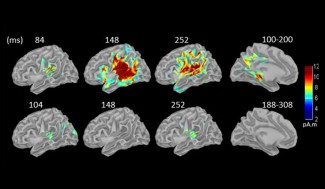Why aren't we aware of outside noises when we sleep? A study, carried out at Neurospin in collaboration with the "Centre du sommeil et de la vigilance" of the Hôtel-Dieu in Paris (AP-HP), the Brain and Spine Institute (Institut du Cerveau - ICM), the College de France and Paris-Sud and Paris-Descartes Universities, shows that even if sounds still penetrate the auditory cortex, sleep disrupts the capacity of the brain to anticipate them.
The researchers showed that the brain is no longer able to make predictions during sleep because the predictive signals from the higher cortical regions seem to be abolished. These results were published in the American journal PNAS on March 2, 2015.
When listening to a melody, the awake brain uses regularities in the sequence of sounds to predict the sounds to come. The ability to predict is based on the functional hierarchy of a group of brain regions. If a sound disrupts the regularity of the sequence, the brain signals a prediction error that is responsible, among others, for reactions to novelty or surprise. Previous electroencephalographic studies identified at least two successive error signals: mismatch negativity (MMN) and P300. MMN was already observed in unconscious subjects (even those in a coma), whereas P300 appears to be specific to conscious treatment since it reflects integration of information across a vast brain network that extends beyond the auditory regions.
During sleep, sounds from the environment are not consciously perceived. However, the level at which the integration of these sounds by the brain is interrupted is not known, or even if the brain is still able to extract the regularities and anticipate them. This specific aspect of brain functioning was tested by a team at Neurospin (Inserm/CNRS), in collaboration with the "Centre du sommeil et de la vigilance" of the Hôtel-Dieu in Paris (AP-HP), the Brain and Spine Institute (Institut du Cerveau - ICM), the College de France and Paris-Sud and Paris-Descartes Universities. The researchers used magnetoencephalography (E/MEG) to study prediction error signals (MMN and P300) in awake and sleeping subjects.
The researchers invited volunteers to sleep in NeuroSpin's magnetoencephalographic apparatus, in the presence of repetitive sounds. The results confirmed that P300 is a specific marker of the conscious treatment of sounds; it disappeared when the patients went to sleep, and the patients no longer reacted to the sounds. Conversely, MMN was observed during all stages of sleep (slow-wave sleep and paradoxical sleep). However, the signal was only partially maintained, since certain brain areas that are normally activated during consciousness no longer responded to the sound stimulus. In effect, the peak of activity resulting from a prediction error in the awake subject disappears during sleep. Only passive phenomena of sensory adaptation, which take place in the primary auditory regions, persist.
The researchers thus demonstrated that, because of a defect in communication between the brain areas, the brain is not able to make predictions during sleep. It is still able, however, to represent the sounds in the auditory regions and to become accustomed to them if they are frequent; this explains why an alarm wakes us up, but not the regular noise of the alarm clock.
Sources
« Disruption of hierarchical predictive coding during sleep », Melanie Strauss, Jacobo D. Sitt, Jean-Remi King, Maxime Elbaz, Leila Azizi, Marco Buiatti, Lionel Naccache, Virginie van Wassenhove and Stanislas Dehaene, in Proceedings of the National Academy of Science (PNAS), mars 2015,







